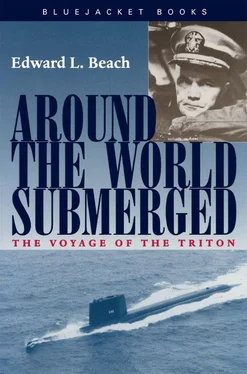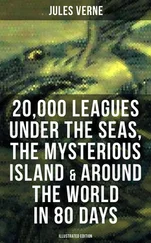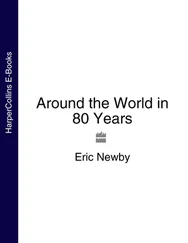1311 Changed course to 180° true to follow behind the freighter. This makes it easy.
1417 Sighted Pearl Bank Light bearing 234° true and obtained the first really good fix of the day.
1436 Commenced transit of Pearl Bank Passage.
1450 We are inside Pearl Bank Passage, taking occasional checks on our position by bearings of the lighthouse on the right and a point of land on the left. We are well behind the freighter and can use our periscope with relative freedom.
The first indication of trouble came when Chief Quartermaster Marshall suggests the situation may be propitious for obtaining a sun azimuth. Will has been doing this every day he can. It is good business to check the accuracy of our gyros and determine their errors as often as possible. The error can vary and there goes your dead-reckoning capability.
A low whistle from Marshall. “This can’t be right,” he comments. “This shows the azimuth is 6° off.” Calling to the navigator in the forward end of the conning tower. “Mr. Adams, are you sure you read the bearing right on the bearing repeater?”
“I think I did,” calls back Adams. “Maybe it is not following freely. Helmsman, mark your head!”
The helmsman, one of our new men, answers immediately, “Mark! One nine one, sir.” With the periscope aimed dead ahead, the bearing repeater should read exactly the same—and it does. Suddenly the pieces fall into place. I shoot a quick look at the rudder angle indicator alongside the helmsman. He has 20° right rudder on, but the ship’s course has not changed!
“Our gyro has gone out,” I call out.
Lt. George Sawyer happens to be officer of the deck. He has reached the same conclusion. “Up periscope!” he shouts.
The handles at the base of the steel tube come up; he grasps them; shouts “Lighthouse—bearing, mark! Left full rudder!”
There is no need for me to look through the periscope to know what George is seeing. When he called “Mark!” he was looking dead ahead. We are at least 90° off our course already, in a narrow channel. George is understandably startled by seeing the lighthouse in front when it should have been on the beam. The urgency in his voice tightens us all up in the conning tower.
With the ship once more on approximately the right heading, we shift steering control to the control room where the helmsman can use the master repeater, the only remote gyro indication we can trust right now.
It is a good lesson to all hands, one which I take pains to expand on in night orders later that same day. It is our normal practice to check our gyro repeaters against the master and auxiliary compasses every 30 minutes. Yet the rapidity with which the situation developed shows us how much trouble we could have gotten into even with this procedure. We were fortunate that we caught the difficulty so quickly, but it was strictly accidental that Marshall thought of taking a sun azimuth at the time he did. Apparently he caught the incipient error when we had only gone six degrees off our course.
The real error was on the part of the helmsman, who should have realized that the ship cannot help turning if 20° rudder is put on. If you have 20° rudder on and you are not changing course, either your rudder or your gyro compass is not working, or something else very unusual is happening. The helmsman must become accustomed to seeing the ship respond ever so slightly to a tiny amount of rudder one way or the other; and if she does not, he should immediately initiate a check to see if anything is wrong.
In this instance the ship was never in danger, since we discovered the difficulty so quickly, and because our sonar equipment has been indicating the shoal water on both sides of Pearl Bank Passage, as it did in Hilutangan Channel; thus we would have known that we were approaching shoal water long before we got in trouble. Even so, the episode has a sobering effect.
1517 Cleared Pearl Bank Passage heading for Sibutu Passage and entry into Celebes Sea.
1856 Entered Sibutu Passage.
2036 Passed Sibutu Island abeam to starboard at about 7 miles.
2200 Passed into Celebes Sea; departed from waters of the Republic of the Philippines.
Sunday, 3 April 1960 1147 Entered Makassar Strait. Departed Celebes Sea.
1330 Sunday Service on schedule, led by Will Adams. Our attendance has increased somewhat—an encouraging sign. Will’s talk, “Have Made Passive Search, Hold No Contacts,” refers to the sonarman’s report made just before we bring the ship to periscope depth. He uses it to illustrate the point that life demands more than a passive search, and the lesson sinks home.
1422 Crossed equator for the third time this voyage at longitude 119°—05.1’ E. We are old hands now, and King Neptune just waves us by as we speed through his domain.
Monday, 4 April 1960 0613 Sighted a sailing vessel to westward. Joe Roberts’ eyes glisten as he evaluates the report. This is the kind of sailboat he has been hoping to photograph, a Makassar inter-island merchantman. As he passes nearby, Joe obtains what should prove to be excellent pictures.
0930 Completed photographing the Makassar merchantman. The vessel in many ways resembles a Chesapeake Bay schooner of a type I had seen many times from my room in Bancroft Hall at Annapolis. It is about 50 feet long, painted white, low in the water with a cargo resembling deck lumber. She has two masts with heavy booms and gaffs. There was also a rather heavy bowsprit and two good-sized jibs—a topsail was rigged between mast and gaff on both fore and main masts. At the stern of the ship was a rather strange outrigger affair, a sort of structure built well out from the stern to which the mainmast backstays are secured and from which the ship is steered. Two men could be seen aboard—one man standing aft on the outrigger, apparently steering the ship, and the other, evidently a deck hand, up forward. Neither one seemed to be aware of our presence, although during our photographic interlude they had passed rather closely and we were able to inspect them carefully.
Strangely, I seemed to recall having seen this schooner somewhere. It soon came to me: in an intelligence photograph taken in this very area during the war. It was indeed quite possible that this was the same sailing vessel, for some of them have been known to survive for a century or more. Steamers are a nondescript lot that wear out in a few years and change mightily in the process. But sailing ships seldom change, their rig seldom varies, until near the end. This is why old sailors can recognize without fail old sailing ships which they know well.
1700 Having come to periscope depth to get a fix on Balalo-hong Island Light, observed up ahead a great deal of splashing in the water; thought for a moment that we might have found the mythical sea serpent. It next appears to be a tide rip similar to one observed earlier today, but upon closer inspection it is evident that these are big fish and little fish, and that the little fish are having a hard time. Maneuvering to close and take pictures of the operation.
There are evidently at least three kinds of fish present. Nearest to us is a lazy group of porpoises swinging along and gamboling among themselves. Up ahead it is evident that the predatory fishes are probably porpoises also, and we cannot understand why the band close aboard is so unconcerned with the battle royal going on just ahead. Perhaps this is a different tribe. Try as we can to approach close enough to get a look at either group, however, we are unable to do so. Apparently they consider us an unwanted witness to whatever is going on. The lazy band of frisky porpoises avoids us by adroit maneuvers at the right time, while up ahead the fighting fish move steadily away and even the ones being eaten seem to co-operate in keeping us at a distance. It is a thrilling sight to see the sleek black bodies of the porpoises flashing around in the water. With their tremendously powerful tails working back and forth like pistons, they dash about at speeds reportedly between 20 and 30 knots. No telling how fast these lads are going, but they certainly seem to have a lot in reserve.
Читать дальше












